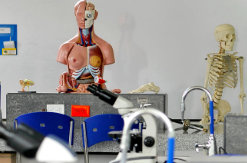Academic Approach
Gimnasio El Hontanar structures its academic proposal on pedagogical theories that respond to the current needs. The learning process of a student starts from experience and reflection. To strengthen one’s skills and abilities, it is aimed to put into practice and context what has been learned; Thus, giving meaning to one’s surroundings, facilitating one’s integral development and generating one’s commitment to its community.

Competences
“Put knowledge in context ” is the definition of “competence “ that Gimnasio El Hontanar follows in its academic approach. In other words, ”Learning is evident when you are able put into practice what you have learned”.
By this definition, Gimnasio El Hontanar’s pedagogical proposal is organized to strengthen the development of skills of a student, so in this way what has been learned can be used in everyday life or in a given context.
Teaching for understanding
Gimnasio El Hontanar applies Teaching for Understanding as a model to follow in its academic processes. Founded through investigations by a group of experts led by Howard Gardner at Harvard University, Teaching for Understanding provides a fundamental supporting tool to strengthen the competences of the students. Understanding is the ability to think and act flexibly, with a strong emphasis on flexibility, and the capacity of using what is learned in new ways.
Multiple intelligences
Gardner’s Multiple Intelligences Theory is also utilized at Gimnasio El Hontanar. Multiple Intelligences Theory is the capacity to solve everyday situations, form educational questions, and create new products or services. Under this Theory, the institution generates a multitude of projects that aim to develop each intelligence proposed in Gardner’s Theory. The Intelligences are as follows:
- Inteligencia Musical: es la capacidad de percibir, discriminar, transformar y expresar las formas musicales. Incluye la sensibilidad al ritmo, al tono y al timbre.
- Body- kinesthetic Intelligence: the capacity to use the body in the expression of ideas and feelings as well as the facility of transforming elements by using the hands including movement, flexibility, and perception.
- Linguistic Intelligence: the capacity of using words in an effective way, orally or written. Including the use of syntax, phonics, semantics and the other pragmatic uses of the language (rhetoric, mnemonics, explanations, and meta-language).
- Logic-mathematical Intelligence: the capacity to use numbers in an effective way and to reason adequately. Including the understanding and forming schemas, logical relationships, affirmations, and propositions, as well as other related abstractions.
- Space Intelligence: the capacity to think in three dimensions. It allows a student to perceive internal and external images, recreate, transform or modify them. The ability to travel through space, make objects travel and to produce or decode graphics.
- Interpersonal Intelligence: the capacity to understand others and to interact with them effectively. This includes the sensitivity to facial expressions, voice, gesture and posture and the ability to answer.
- Intrapersonal Intelligence: the capacity to build a precise perspective of your own and to organize and lead your own life. This includes self-discipline, self-understanding, and self-esteem.
































